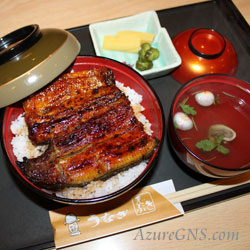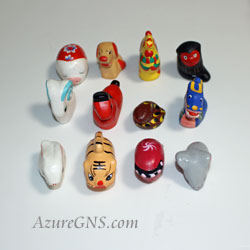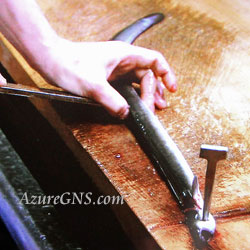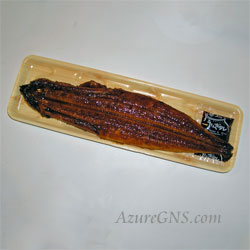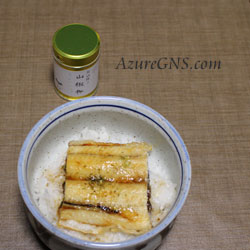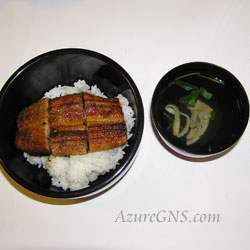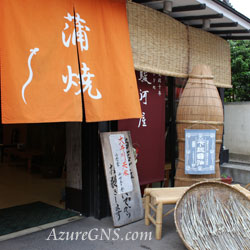(7月20日頃)
Doyo-no-ushi-no-hi;
The Dog Days of Summer
(on or around July 20th)
●土用 Doyo; the hottest time of summer; “the Dog Days of summer”
●鰻 eel
●鰻の蒲焼き unagi-no-kabayaki; eel split and grilled with special teriyaki sauce;
spitchocked eel seasoned with special teriyaki sauce
●串 (木・金属製の)skewer; (金属製の)spit
●串に刺した skewered
●~を串焼きにする (to) roast ~ on a skewer; (to) broil ~ on a skewer
●醤油 shoyu; soy sauce
●味醂 mirin; sweet rice wine
●酒 sake; rice wine
●砂糖 sugar
●肝 liver
●栄養がある nutritious
●夏ばて summer lethargy
●養殖 cultivation
●養殖する (to) cultivate
●輸入(する) import
◆日本では旧暦の新しい季節の始まりの日にそれぞれ名前があります。
In Japan, according to the lunar calendar, the first day of each season has a name.
◆春は立春、夏は立夏、秋は立秋、冬は立冬です。
The spring is Risshun, the summer is Rikka, the autumn is Risshu, and the winter is Ritto.
◆土用とは立春、立夏、立秋、立冬の前の18日間のことです。
Doyo is celebrated 18 days before the start of each season (Risshun, Rikka, Risshu and Ritto).
◆しかし現在では一般に土用と言えば立秋前の18日間をさします。
Nowadays, however, Doyo has come to mean the 18 days before Risshu.
◆立秋は秋の始まりで、日本ではたいがい一年で一番暑い時です。
Risshu is the beginning of autumn, and this is usually the hottest time of the year in Japan.
◆旧暦では十二支を1日ごとに当てはめていきます。
In the lunar calendar, Juni-shi, the twelve signs of the Chinese zodiac are used to designate the days of the month.
◆十二支は子(鼠)、丑(牛)、寅(虎)、卯(兎)、辰(竜)、巳(蛇)、午(馬)、未(羊)、申(猿)、酉(鳥)、戌(犬)、亥(猪)です。
The Juni-shi signs are Ne (Rat), Ushi (Ox), Tora (Tiger), U (Rabbit), Tatsu (Dragon), Mi (Snake), Uma (Horse), Hitsuji (Sheep), Saru (Monkey), Tori (Chicken), Inu (Dog) and I (Wild Boar).
◆18日の間に1度か2度丑の日がやってきます。
Ushi-no-hi (the ox day) comes around once or twice during the 18-day Doyo period.
◆人々は土用の丑の日に鰻の蒲焼を食べます。
People eat unagi-no-kabayaki, an eel split and grilled with special teriyaki sauce on Doyo-no-ushi-no-hi.
◆タレは醤油、みりん、酒、砂糖で作ります。
This special teriyaki sauce is made from shoyu (soy sauce), mirin (sweet rice wine), sake (rice wine), and sugar.
◆関東では鰻は背開き、関西では腹開きにされます。
In the Kanto district, the eel is cut lengthwise from the back side, and in the Kansai district, it is cut lengthwise from the stomach side.
◆これは関東が武士の中心地だったからです。
This is because of the Samurai influence on the Kanto area culture.
◆武士が切腹をイメージする腹開きを嫌ったからです。
The Samurai didn’t like to cut the eels stomach because it recalled images of Seppuku (Hara-kiri); the Samurai’s suicide ritual.
◆鰻はあまり家では料理しないで、たいてい焼きあがったものを買って来るか、お店で食べます。
People seldom cook eel at home, instead buying grilled eels from the shops or grocery stores or eat it at restaurants.
◆鰻の蒲焼にはしばしば香辛料として山椒の粉が使われます。
The powder of sansho (Sichuan pepper) is often used for unagi-no-kabayaki as a condiment.
◆鰻のもっとも一般的な食べ方は鰻丼です。
The most popular way to eat eel is unagi-domburi (unagi-no-kabayaki over rice in bowl.)
◆しばしば肝吸いも鰻の蒲焼と一緒に食べられます。
Kimo-sui, clear soup made from eel liver, is often eaten with unagi-no-kabayaki.
◆鰻はとても栄養価が高く、夏バテ防止になります。
Eel is very nutritious and prevents summer lethargy.
◆土用の丑の日に鰻の蒲焼を食べる習慣は江戸時代(1603-1867)中期より続いています。
The custom of eating unagi-no-kabayaki on Doyo-no-ushi-no-hi has continued since the middle of the Edo era (1603-1867).
◆江戸中期の博物学者、文芸者、芸術家であった平賀源内の発案であったと言われています。
Gennai Hiraga, a naturalist, writer, and artist in the middle of the Edo era, is said to have started this tradition.
◆夏場に鰻の売り上げが落ちるので、鰻屋が平賀源内に相談しました。
An eel seller complained to Gennai Hiraga that he couldn’t sell many eels during the summer.
◆すると平賀源内が「けふ(今日)は丑の日」と書いて鰻屋の宣伝にしました。
Then, Gennai Hiraga wrote “Today is Ushi-no-hi” and used it to advertise the eel shop.
◆近年、天然の鰻はあまり獲れなくなり、大半は養殖物ですが、それでは値段は年々上がっています。
Recently, very few eels are caught in the wild; most are cultivated, and the price has been rising year by year.
◆韓国、台湾、中国からたくさんの鰻が輸入されるようになりました。
A great number of eels are imported from Korea, Taiwan, and China.
◆日本産の鰻の値段は輸入物の約2倍ですが、輸入物より人気があります。
Japanese eels are more popular than imported ones though Japanese ones are twice as expensive as imported ones.
◆土用の丑の日には鰻だけでなく「土用餅」と呼ばれるあんころ餅などの和菓子が食べられます。
People eat “Doyo-mochi” (Japanese rice cake for Doyo-no-ushi-no-hi) such as Ankoro-mochi (a rice cake covered with anko, sweetened bean-paste) as well as eel on Doyo-no-ushi-no-hi.
◆地方によっては、この日に「土用蜆」(どようしじみ)を食べます。
In some regions, “Doyo-shijimi” (Japanese small freshwater clams for Doyo-no-ushi-no-hi) is also eaten on this day.
(より詳しい情報は「我が家の土用の丑の日」をご覧下さい。)
(Please see “Our Dog Days of Summer Experience” for further information.)
Copyright (C) Azure Global Network Services. All Rights Reserved.
